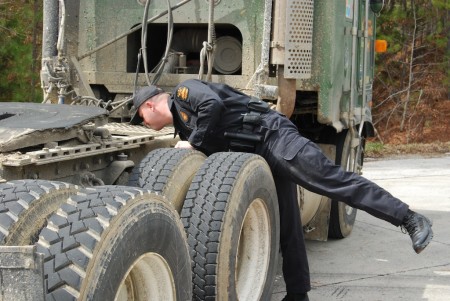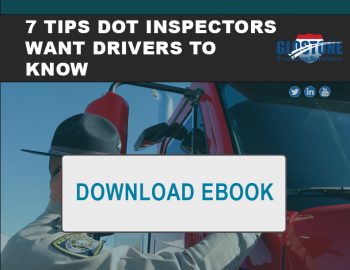
5 Things DOT Inspectors Want Drivers to Know
posted in Alerts, Blog, Uncategorized by Brian Gray
5 Things DOT Inspectors Want Drivers to Know
As you near a weigh -station, DOT inspectors are pulling drivers’ basic information up on their screens. There are three things inspectors look for first: ISS (Inspection Selection System) score, vehicle out-of-service score, and driver out-of-service score.
These scores are color coded based on the score level. If a score is near or worse than the national average, the score will be highlighted red. If the score is just below the national average, the score will be highlighted yellow. If the score is in a healthy position, the score will be highlighted green. Inspectors are looking to see if there is a lot of red or yellow across their screen. If there are 3 red scores, you will be pulled in for an inspection.
On occasion, if the rating system does not have enough data on a carrier to give basic scores (because they are a good carrier and they always get waived through scales) we have seen the system spike the company ISS score just to generate some inspection data. Once they get 3-5 inspections, the ISS returns to normal.
-
Some Reasons Why a Driver May be Inspected at a Weigh-station
-
If a driver’s ISS or Out-of-service ratings are near or worse than the national average.
- Driver Out-of-Service national average = 5.5%
- Vehicle Out-of-Service national average = 20.7%
- ISS Score
- 1-49 = Passing
- 50-74 = Optional
- 75-100 = Inspect
-
If you have a headlight out, it may bring attention to you.
Inspectors may assume the driver did not do a good pre-trip inspection because it is unlikely the headlight goes out between two stations. Inspectors may assume there are other maintenance violations or a lack of a maintenance program, and will look at tires, lug-nuts, lights, etc. in more detail.
-
If your truck is dirty, it may bring attention to you.
If the truck is not taken care of properly, inspectors may assume that the driver might not fix bigger problems, such as brakes, suspension, or other more serious issues. Inspectors will look more closely at these areas for violations.
-
Sometimes, inspections are just completely random.
Inspectors are known to bring drivers in randomly for inspection. They may set-up a certain ration, such as 1:4 trucks driving by will be pulled in for a limited time.
-
What the different Levels of Inspection mean:
Drivers have a lot of differing opinions on what each level of inspection actually mean. Below is a summary of each type of truck safety inspections conducted throughout North America.
- LEVEL I — A complete inspection that includes a check of the driver´s license, medical examiner´s certificate (and waiver, if any), alcohol and drugs, hours of service, seat belt, vehicle inspection report, brake system, coupling devices, exhaust system, frame, fuel system, turn signals, brake and tail lamps, headlamps, lamps on loads, load securement, steering, suspension, tires, van and open-top trailer bodies, wheels and rims, windshield wipers, emergency exits on buses and hazardous materials requirements, as applicable.
- LEVEL II — A “walk-around” inspection that includes a check of each of the items in a Level I inspection but not items that require the inspector to physically get under the truck.
- LEVEL III — An inspection of just the driver-related items in a Level I inspection.
- LEVEL IV — A special inspection, typically a one-time examination of a particular item for a safety study or to verify or refute a suspected trend.
- LEVEL V — An inspection of just the truck-related items in a Level I inspection.
- LEVEL VI — An inspection of a shipment of highway-route-controlled quantities of radiological material. A Level VI inspection includes an enhanced check of each of the items in a Level I inspection.
-
How to treat your DOT Inspectors
DOT Inspectors understand that coming in for an inspection are keeping drivers from driving and can be a nuisance. Inspectors talk to many different types of drivers every day. Like a referee in sports, treating the inspectors with respect is the best way to prevent any detailed inspection and will help you get on the road more quickly. A common request by inspectors is if they asks driver questions, provide the answer and everything will move more smoothly.
In situations when a driver is giving lots of attitude toward the inspector, some inspectors may respond more harshly in their inspection, they are human after all. Some inspectors, not all, may have a chip on their shoulder or have a “heavy badge”, which is understandably irritating in the drivers’ perspective.
However, if you treat an inspector respectfully, inspectors are more likely to explain what they are looking at and why you may have received a violation. Also, if you respectfully complain about being pulled in several times in the last day or two, most inspectors will explain what they see on their screens and why this inspection is currently happening – giving you the chance to understand what needs to be fixed to prevent inspections in the future. Additionally, if you show them the most recent inspection forms, they may just let you pass.
-
DOT Inspectors Perspective on ELDs
With the mandatory adoption of ELDs coming down the road, it is interesting to look at some DOT inspectors’ perspectives when drivers with an ELD come in for an inspection.
If a truck currently has an ELD or other e-log type of devise, drivers may find inspectors not wanting to waste their time looking over your driving logs. ELDs help driver logs stay compliant and inspectors usually do not find errors on the logs. Some inspectors even worry about those devices that give the home terminal access where they can abuse the data and change the logs to hide violations.
However, with the ELD rule currently on the books, drivers may find that they are asked to bring up their ELD logs in order to help inspectors get use to the new process. In these situations, inspectors tend to look for manipulations, such as using a ghost-driver (logging a second driver as on-duty when only one driver in the truck) or for a 5th “personal conveyance” line.







